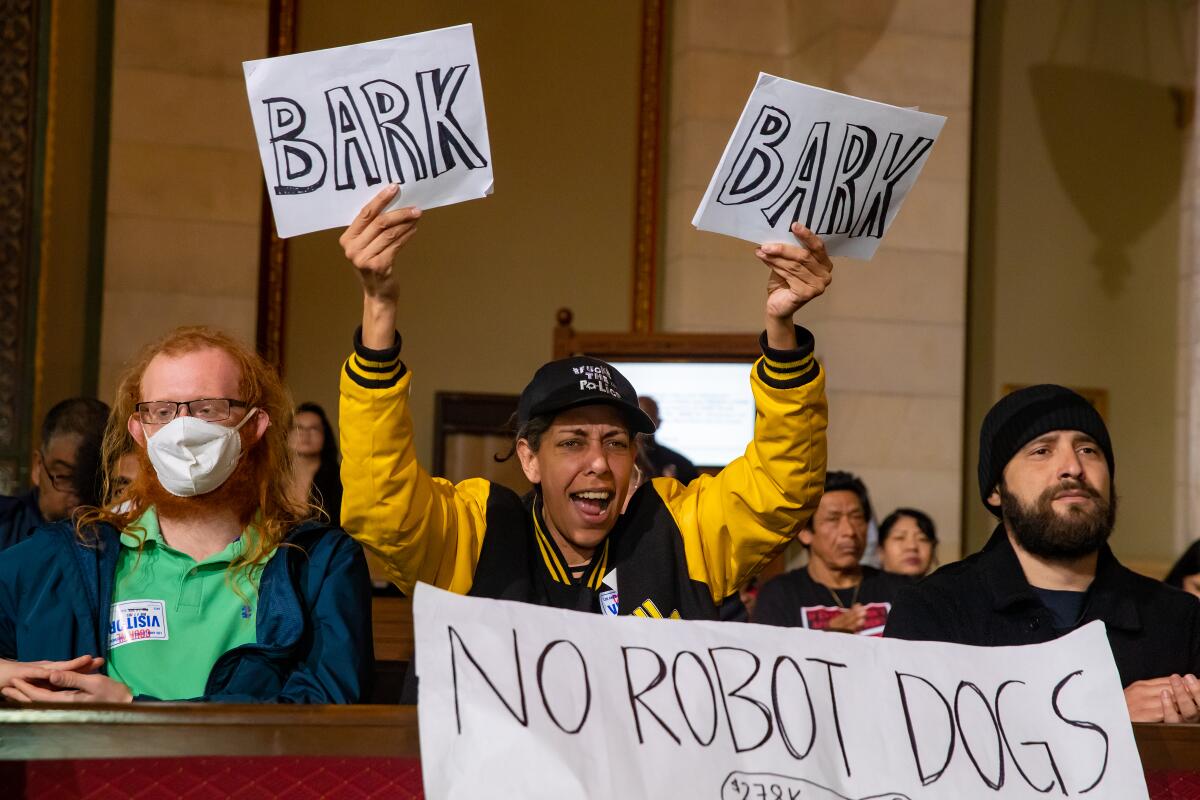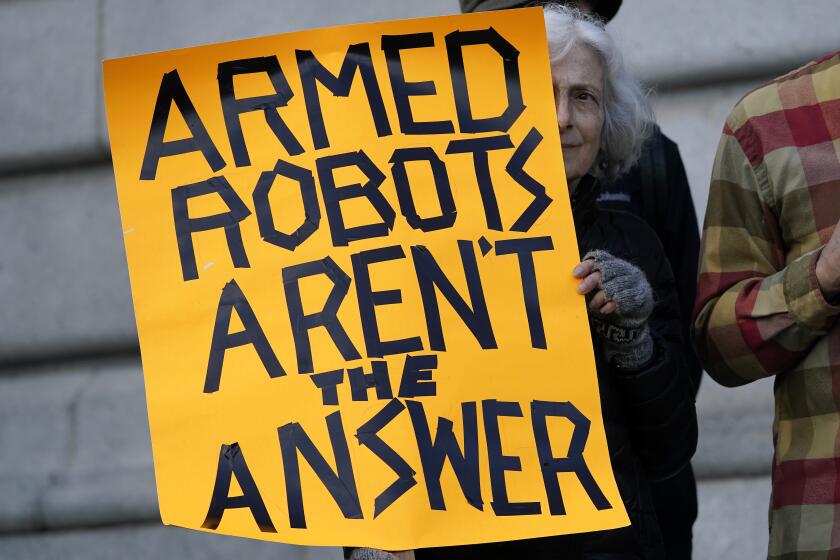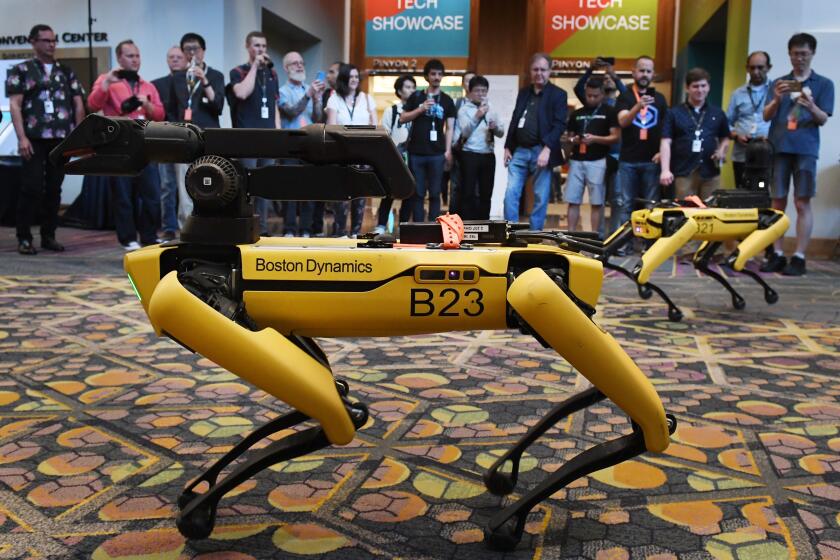City Council votes to accept donation of controversial LAPD robot dog

- Share via
Amid lingering concerns about surveillance and safety, the Los Angeles City Council voted Tuesday to accept the donation of a nearly $280,000 dog-like robot for the Police Department’s use.
The 8-4 vote followed more than a dozen public comments urging council members to vote against the controversial device, which would be paid for with a donation from the Los Angeles Police Foundation.
Council members also approved a plan to have the Los Angeles Police Department provide quarterly reports on deployment of the device, including where and why it was deployed, the outcome and any issues.
“This item is being painted as merely an acceptance of a donation, but it really represents an expansion of the current boundaries around policing and surveillance,” Councilmember Hugo Soto-Martínez said before voting no. “This is not the vision of the community that I believe Los Angeles should be.”
Although the vote was a majority in favor, none of the council members Tuesday explained why they endorsed the move. Councilmember Traci Park, who voted for the device, previously dismissed the suggestion that the robot would put the department “on a path towards a dystopian, Orwellian future of state surveillance.”
After the vote, members of the public erupted in shouts and called council President Paul Krekorian “disgusting.” A group of protesters who became disruptive were ejected, according to LAPD spokeswoman Kelly Muniz.
Minutes later, a man in a puffy black jacket scrawled a series of anti-police messages with permanent marker on the marble walls of the third floor leading into the council chamber. Police chased the man through City Hall, but he got away.
A crime report for vandalism has been taken and will be investigated, according to Muniz.
The drama Tuesday followed a months-long delay on the vote to allow council members “the opportunity to exhaust every opportunity to have responses to the questions that have been raised about existing deployment capabilities and so forth,” Krekorian said in March.
Police officials said the device would be deployed only in a limited set of circumstances that require a SWAT team response. The device — nicknamed Spot — can climb stairs, open doors and navigate rugged terrain.
The LAPD plans to acquire a canine-like robot. Authorities say the technology will help, but critics worry the technology will mostly be used in poor areas.
Standing almost 28 inches and weighing 70 pounds, Spot is roughly the size of a full-grown Dalmatian. Equipped with 360-degree cameras, the robots collect and process information about their surroundings, which is transmitted in real time to an officer controlling their movements with a tablet-like device. It can be customized with a mechanical arm to open doors, or sophisticated sensors capable of detecting chemical spills and creating a three-dimensional map of an area.
Its presence, officials argue, would allow authorities to avoid unnecessarily putting officers in harm’s way and potentially avoid violent encounters.
The City Council is set to vote on whether to accept the donation of a four-legged robot for the LAPD.
Critics pushed back on that claim, expressing concern about the potential for the device to be used to harm and spy on Black and brown communities.
Hamid Khan, with the oversight group Stop LAPD Spying Coalition, said the LAPD in the past has justified new technology and programs by saying they would be used only in narrow circumstances. Then, he said, deployment was expanded.
“This is what’s going to happen to the robot dog as well,” Khan said. “For us, it’s also the trauma of police robots walking all over the place. And yes it’s only one, but it’s going to expand.”
At Tuesday’s meeting, several people echoed those concerns throughout public comment. One man told the council he didn’t want to “arm AI.” Another, in expressing his opposition, asked the council: “Didn’t you guys see that movie ‘I, Robot’ and ‘[The] Terminator?’”
Others expressed concern about the cost. Although the device will be paid for with a donation, the city would be on the hook for future maintenance and repairs.
“Officers are not trained to use this equipment, so where will the money come from when it’s time to start training officers to use the equipment?” Amerald Wheatley-Johnson, with the L.A. Community Action Network, asked. “Where will the money come from when you decide to expand this technology? It’s not just a donation, and this will cost us a lot more in the long run.”
Ahead of the vote, Soto-Martínez questioned Brendan Schulman, vice president of policy and government for Boston Dynamics, the manufacturer of the device, and David Kowalski, deputy chief for the LAPD.
Kowalski pointed to other police departments in California that have added the device to their inventory and have called it, he said, “a game changer” and a “risk mitigator.”
Soto-Martínez pointed to the robotic canine’s disastrous deployment in New York City.
The nation’s largest police force first acquired the technology in 2020. Its use didn’t get widespread attention until the next year, when it sparked public outcry after a viral video showed the robot trotting alongside New York City officers during a hostage situation at a high-rise public housing building.
Critics denounced the decision to use the device in what they said is an over-policed community, and they also raised concerns about privacy and data collection. After several days, the New York City Police Department broke its contract with Boston Dynamics and returned the robot.
“This is a highly disturbing automation of law enforcement that sets a dangerous precedent for our future and our community’s safety and for that I’ll be voting no,” Soto-Martínez said.
Councilmembers Heather Hutt, Curren Price and Nithya Raman also voted against accepting the donation.
Councilmember Eunisses Hernandez, who has been opposed to the donation, was not present Tuesday to weigh in. Hernandez’s spokesperson said she was attending the Vienna Social Housing Field Study, a weeklong study of social housing in Vienna to learn “more about this housing framework and how it might be applied to address the housing and homelessness crisis in Los Angeles.”
Councilmember Marqueece Harris-Dawson, who also missed Tuesday’s meeting, is also in Vienna this week.
After the vote, Khan, with the Stop LAPD Spying Coalition, expressed his frustration.
“The LAPD completely controls the city, they control the finances and the City Council constantly keeps on catering more and more to what their demands are,” he said.
The council, he said, turned “a blind eye to what the people are saying. It was an overwhelming rejection from every speaker.”
Times staff writers Libor Jany and David Zahniser contributed to this report.
More to Read
Sign up for Essential California
The most important California stories and recommendations in your inbox every morning.
You may occasionally receive promotional content from the Los Angeles Times.












